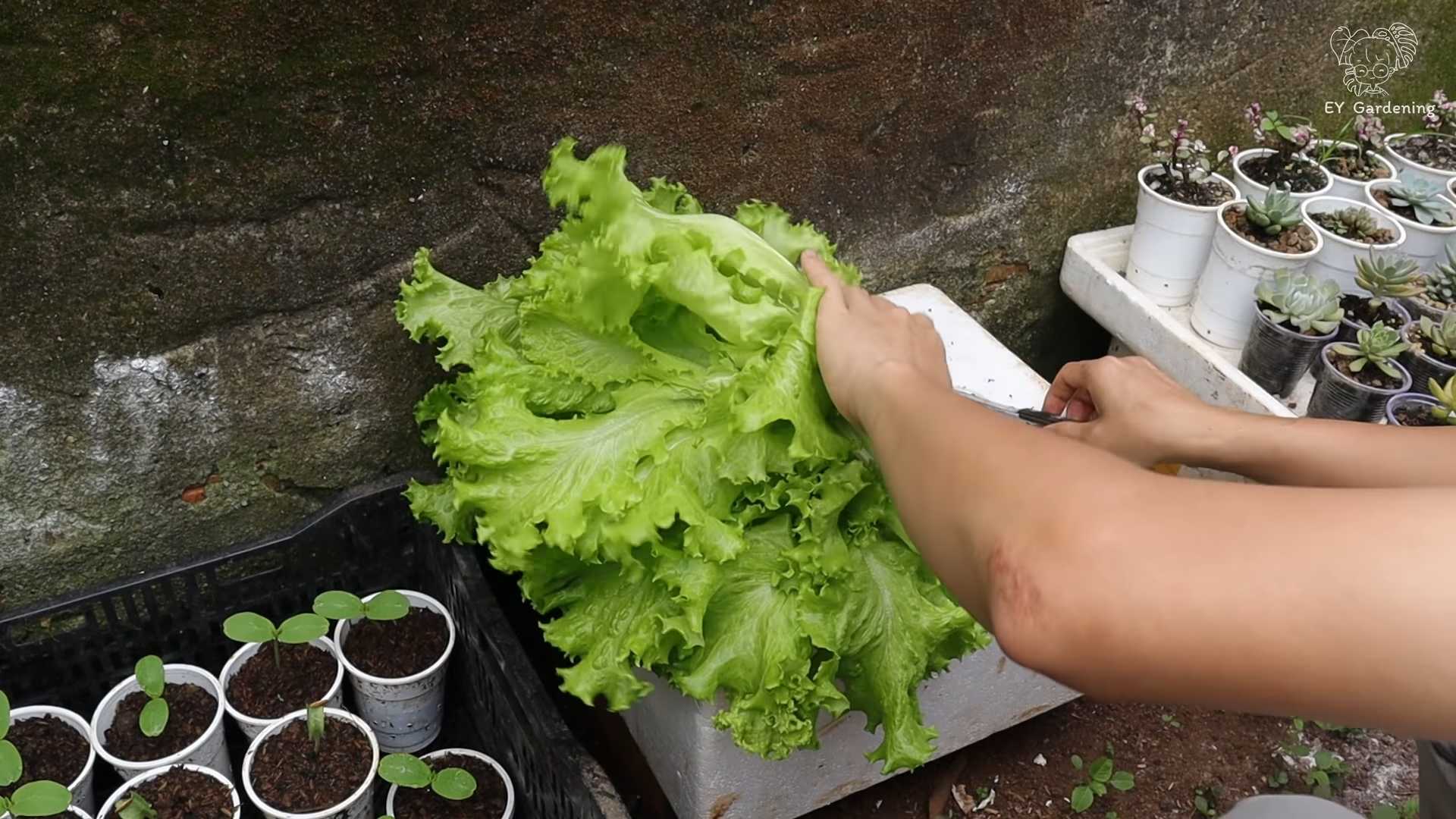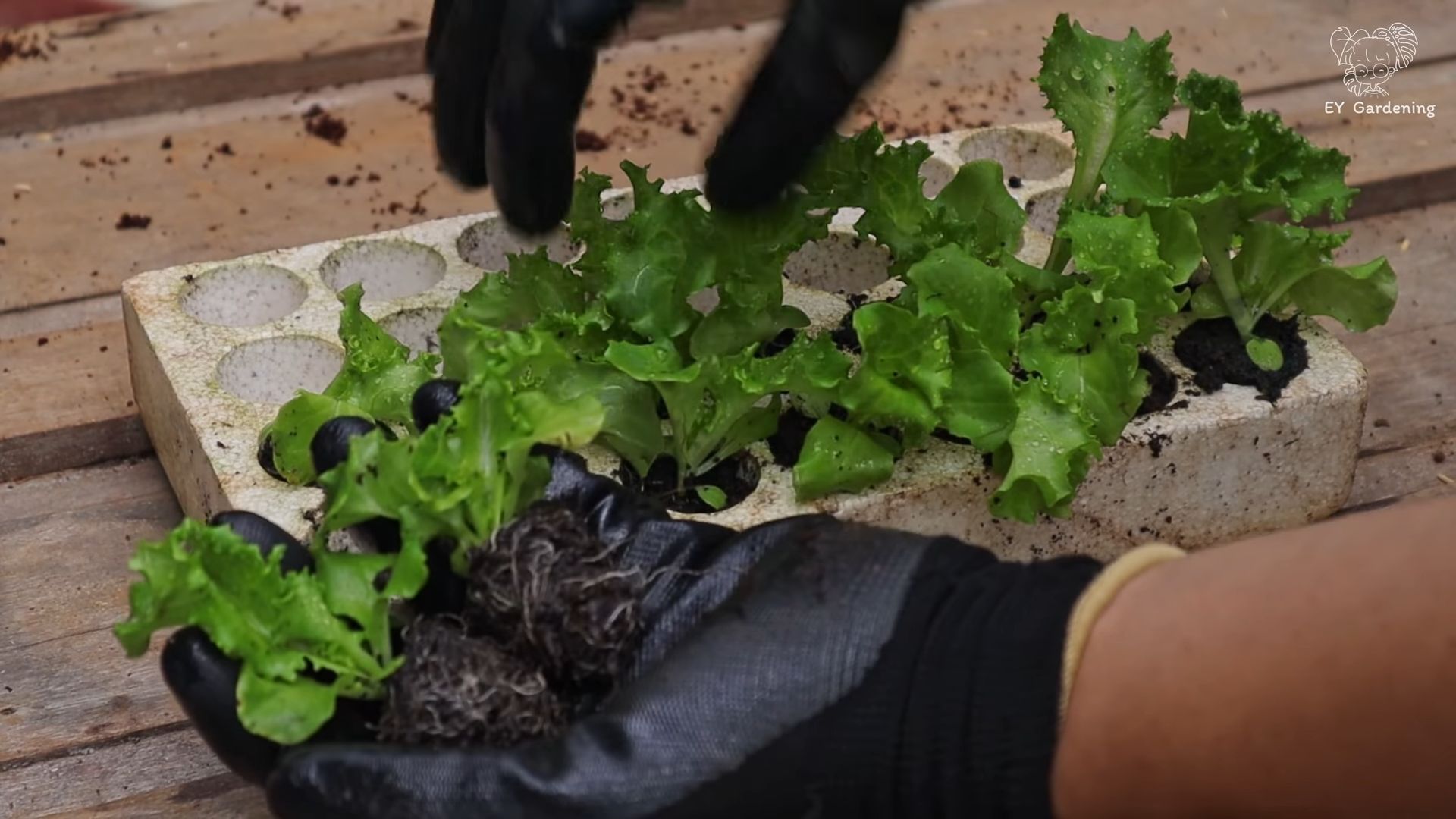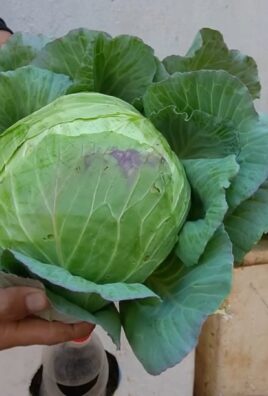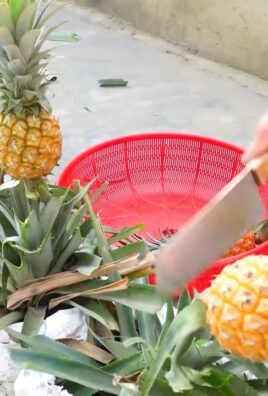Growing Lettuce at Home can be surprisingly easy and incredibly rewarding! Imagine stepping outside your back door and harvesting fresh, crisp lettuce for your salad, sandwich, or even a quick snack. No more wilted, overpriced greens from the grocery store – just vibrant, healthy lettuce grown with your own two hands.
For centuries, cultivating lettuce has been a staple in gardens worldwide. From ancient Egyptians who first cultivated it for its seeds and oil to the Romans who spread its popularity throughout Europe, lettuce has a rich history as a nutritious and versatile food source. Today, with concerns about food miles and the desire for fresher, healthier options, growing lettuce at home is experiencing a major resurgence.
But let’s be honest, sometimes gardening feels intimidating, right? That’s where these DIY tricks and hacks come in! I’m here to share some simple, effective methods that will help you successfully grow lettuce, even if you’re a complete beginner. We’ll cover everything from choosing the right varieties and preparing your soil to protecting your plants from pests and harvesting your bounty.
Why do you need these DIY tricks? Because everyone deserves access to fresh, healthy food, and growing your own lettuce is a fantastic way to achieve that. Plus, it’s a fun, relaxing, and educational activity for the whole family. So, let’s get started and transform your backyard (or even your balcony!) into a thriving lettuce garden!

Growing Lettuce at Home: A Beginner’s Guide to Fresh, Crisp Greens
Okay, lettuce lovers! Are you tired of buying wilted, overpriced lettuce from the grocery store? I know I was! That’s why I decided to take matters into my own hands and start growing my own. And guess what? It’s way easier than you think! This guide will walk you through everything you need to know to cultivate a thriving lettuce patch right in your backyard (or even on your balcony!).
Choosing Your Lettuce Varieties
First things first, let’s talk lettuce types. There are so many delicious varieties to choose from, each with its own unique flavor and texture. Here are a few of my favorites:
* **Romaine:** The classic choice for Caesar salads! It has crisp, upright leaves and a slightly bitter taste.
* **Butterhead (Boston or Bibb):** These varieties have soft, delicate leaves and a mild, buttery flavor. They’re perfect for simple salads or lettuce wraps.
* **Loose-leaf:** This is a great option for beginners because you can harvest individual leaves as needed. Popular loose-leaf varieties include Red Sails, Black Seeded Simpson, and Oakleaf.
* **Crisphead (Iceberg):** While not the most nutritious option, iceberg lettuce is known for its crisp texture and mild flavor. It’s a good choice for sandwiches and salads where you want a bit of crunch.
Pro Tip: Consider planting a mix of different lettuce varieties for a diverse and flavorful salad bowl!
Getting Started: Seeds vs. Seedlings
You have two main options for starting your lettuce garden: seeds or seedlings (also known as transplants).
* **Seeds:** Starting from seed is the most economical option, and it gives you the widest selection of varieties. However, it requires a bit more patience and attention to detail.
* **Seedlings:** Buying seedlings from a nursery or garden center is a quicker and easier way to get started. You’ll have a head start on the growing season, and you won’t have to worry about the initial germination process.
I personally prefer starting from seed because I enjoy the whole process, but if you’re short on time or new to gardening, seedlings are a great choice.
Preparing Your Growing Space
Lettuce thrives in cool weather and needs at least six hours of sunlight per day. Here’s how to prepare your growing space:
* **Choose a location:** Select a spot in your garden that receives morning sun and afternoon shade, especially in warmer climates. If you’re growing in containers, make sure they’re placed in a sunny location.
* **Prepare the soil:** Lettuce prefers well-drained, fertile soil with a pH between 6.0 and 7.0. Amend your soil with compost or other organic matter to improve its drainage and fertility. I like to add a generous amount of composted manure to my lettuce beds.
* **Consider raised beds or containers:** Raised beds and containers are a great option if you have poor soil or limited space. They also make it easier to control weeds and pests.
Planting Your Lettuce
Now for the fun part: planting!
Planting from Seed
1. **Sow the seeds:** Sow lettuce seeds directly into the soil about ¼ inch deep and ½ inch apart. You can also start seeds indoors 4-6 weeks before the last expected frost.
2. **Water gently:** Water the soil gently after planting to avoid disturbing the seeds.
3. **Thin the seedlings:** Once the seedlings emerge, thin them to about 6-12 inches apart, depending on the variety. This will give them enough room to grow and mature. I usually wait until they have a few true leaves before thinning.
4. **Keep the soil moist:** Lettuce needs consistent moisture to thrive. Water regularly, especially during dry spells.
Planting Seedlings
1. **Dig holes:** Dig holes that are slightly larger than the root balls of the seedlings. Space the holes 6-12 inches apart, depending on the variety.
2. **Remove the seedlings from their containers:** Gently remove the seedlings from their containers, being careful not to damage the roots.
3. **Place the seedlings in the holes:** Place the seedlings in the holes and backfill with soil.
4. **Water thoroughly:** Water the seedlings thoroughly after planting.
Caring for Your Lettuce
Once your lettuce is planted, it’s important to provide it with the care it needs to thrive.
* **Watering:** Lettuce needs consistent moisture, especially during hot weather. Water deeply and regularly, but avoid overwatering, which can lead to root rot. I usually water my lettuce every other day, or more often if the weather is particularly hot and dry.
* **Fertilizing:** Lettuce is a light feeder, but it will benefit from occasional fertilization. Use a balanced fertilizer or a fertilizer specifically formulated for leafy greens. I like to use a liquid seaweed fertilizer every few weeks.
* **Weeding:** Keep your lettuce patch free of weeds, which can compete with the lettuce for nutrients and water. Hand-pull weeds regularly or use a hoe to cultivate the soil.
* **Pest control:** Lettuce is susceptible to a few common pests, such as aphids, slugs, and snails. Inspect your plants regularly for signs of infestation and take action as needed. I like to use organic pest control methods, such as insecticidal soap or diatomaceous earth.
* **Bolting:** Bolting is when lettuce plants send up a flower stalk and become bitter. This usually happens when the weather gets too hot. To prevent bolting, plant lettuce in a shady location or use shade cloth to protect it from the sun. You can also choose bolt-resistant varieties.
Harvesting Your Lettuce
The best part of growing your own lettuce is harvesting it!
* **Harvesting loose-leaf lettuce:** You can start harvesting loose-leaf lettuce as soon as the leaves are large enough to eat. Simply snip off the outer leaves with scissors or a knife, leaving the inner leaves to continue growing.
* **Harvesting head lettuce:** Head lettuce is ready to harvest when the head is firm and well-formed. Cut the head off at the base of the plant with a sharp knife.
* **Harvesting time:** Harvest lettuce in the morning, before the sun gets too hot. This will help to prevent wilting.
Storage Tip: To store lettuce, wash it thoroughly and dry it with a salad spinner or paper towels. Store it in a plastic bag in the refrigerator. It will keep for several days.
Troubleshooting Common Problems
Even with the best care, you may encounter some problems when growing lettuce. Here are a few common issues and how to address them:
* **Yellowing leaves:** Yellowing leaves can be caused by a variety of factors, including overwatering, underwatering, nutrient deficiencies, or pests. Check the soil moisture and nutrient levels and inspect the plants for pests.
* **Wilting leaves:** Wilting leaves are usually a sign of underwatering or heat stress. Water the plants deeply and provide shade if necessary.
* **Holes in leaves:** Holes in leaves are often caused by slugs, snails, or other pests. Inspect the plants for pests and take action as needed.
* **Bitter taste:** A bitter taste is usually a sign of bolting. Plant lettuce in a shady location or choose bolt-resistant varieties.
Extending Your Lettuce Season
Lettuce is a cool-season crop, but you can extend your growing season by using a few simple techniques:
* **Succession planting:** Sow new seeds every few weeks to ensure a continuous supply of lettuce throughout the season.
* **Cold frames or row covers:** Use cold frames or row covers to protect your lettuce from frost and extend the growing season into the fall and winter.
* **Choose heat-tolerant varieties:** Select lettuce varieties that are known to be more tolerant of heat.
Enjoying Your Homegrown Lettuce
Now that you’ve harvested your delicious homegrown lettuce, it’s time to enjoy it! Here are a few ideas:
* **Salads:** The classic choice! Use your lettuce as the base for a variety of salads, adding your favorite toppings and dressings.
* **Sandwiches and wraps:** Use lettuce as a crunchy and refreshing addition to sandwiches and wraps.
* **Lettuce wraps:** Use large lettuce leaves as a healthy and delicious alternative to tortillas or bread.
* **Smoothies:** Add a handful of lettuce to your smoothies for a boost of vitamins and minerals.
Growing your own lettuce is a rewarding experience that will provide you with fresh, healthy greens all season long. With a little bit of planning and care, you can enjoy a thriving lettuce patch right in your own backyard. Happy gardening!

Conclusion
So, there you have it! Growing lettuce at home, especially with this simple DIY trick, is not only achievable but also incredibly rewarding. Forget those limp, overpriced heads of lettuce from the grocery store. Imagine stepping out into your garden or onto your balcony and harvesting crisp, vibrant leaves whenever you need them. The difference in taste and texture is truly remarkable – a freshness you simply can’t replicate with store-bought produce.
This method, focusing on container gardening and strategic planting, allows even those with limited space to enjoy a continuous supply of fresh lettuce. It’s a fantastic way to reduce your carbon footprint, save money, and connect with nature, even in the heart of the city. Plus, it’s a great project for kids, teaching them about where their food comes from and fostering a love for gardening.
But the benefits don’t stop there. By controlling the growing environment, you can minimize the risk of pests and diseases, ensuring a healthier and more abundant harvest. You’ll also know exactly what’s going into your lettuce – no harmful pesticides or herbicides, just pure, natural goodness.
Why is this DIY trick a must-try? Because it’s easy, efficient, and yields delicious results. It’s a game-changer for anyone who loves fresh salads and wants to take control of their food supply.
Ready to take your lettuce growing to the next level? Consider experimenting with different varieties. Romaine, butterhead, loose-leaf – each offers a unique flavor and texture profile. You can also try succession planting, sowing new seeds every few weeks to ensure a continuous harvest throughout the growing season. Another variation is to incorporate companion planting. Marigolds, for example, can help deter pests, while herbs like basil can enhance the flavor of your lettuce.
Don’t be afraid to get creative and adapt this DIY trick to your specific needs and preferences. Whether you’re a seasoned gardener or a complete beginner, you’ll be amazed at how easy it is to grow your own lettuce at home.
We’re confident that you’ll love the results. So, grab your seeds, prepare your containers, and get ready to enjoy the freshest, most flavorful lettuce you’ve ever tasted.
We encourage you to try this DIY trick and share your experience with us! Let us know what varieties you’ve grown, what challenges you’ve faced, and what tips you’ve discovered along the way. Share your photos and stories on social media using #HomegrownLettuce and inspire others to join the movement. Together, we can create a community of passionate gardeners who are committed to growing their own food and enjoying the many benefits of fresh, homegrown produce. Happy gardening!
Frequently Asked Questions (FAQ)
What kind of container is best for growing lettuce?
The best container for growing lettuce is one that is at least 6 inches deep and has good drainage. You can use plastic pots, terracotta pots, raised beds, or even repurposed containers like buckets or old tires. The key is to ensure that the container is large enough to accommodate the root system of the lettuce plants and that it allows excess water to drain away freely. Avoid containers that are too shallow or that don’t have drainage holes, as these can lead to waterlogged soil and root rot. Consider the material of the container as well. Dark-colored containers can heat up quickly in direct sunlight, which can stress the lettuce plants. Lighter-colored containers or those made from breathable materials like terracotta are generally better choices.
How often should I water my lettuce plants?
Lettuce plants need consistent moisture to thrive, but they don’t like to be waterlogged. The frequency of watering will depend on several factors, including the weather, the type of container you’re using, and the type of soil. As a general rule, water your lettuce plants when the top inch of soil feels dry to the touch. During hot, dry weather, you may need to water them every day, while during cooler, wetter weather, you may only need to water them every few days. When watering, be sure to soak the soil thoroughly, but avoid getting water on the leaves, as this can promote fungal diseases. It’s best to water in the morning so that the leaves have time to dry out before nightfall. You can also use a moisture meter to help you determine when your lettuce plants need water.
What kind of soil is best for growing lettuce?
Lettuce prefers well-draining, fertile soil that is rich in organic matter. A good potting mix specifically formulated for vegetables is a great option. You can also amend your existing garden soil with compost, aged manure, or other organic materials to improve its drainage and fertility. The ideal soil pH for lettuce is between 6.0 and 7.0. You can test your soil pH using a soil testing kit and adjust it accordingly. Avoid using heavy clay soil, as this can become waterlogged and prevent the roots from getting enough oxygen. If you have clay soil, you can improve its drainage by adding sand and organic matter.
How much sunlight does lettuce need?
Lettuce needs at least 6 hours of sunlight per day to thrive. However, it can also tolerate partial shade, especially during the hottest part of the day. If you live in a hot climate, it’s best to provide your lettuce plants with some afternoon shade to prevent them from bolting (going to seed prematurely). If you’re growing lettuce indoors, you’ll need to provide it with supplemental lighting, such as grow lights. Place the grow lights about 6-12 inches above the plants and keep them on for 12-14 hours per day.
What are some common pests and diseases that affect lettuce?
Some common pests that affect lettuce include aphids, slugs, snails, and cutworms. Aphids can be controlled with insecticidal soap or neem oil. Slugs and snails can be handpicked or trapped using beer traps. Cutworms can be prevented by using cutworm collars around the base of the plants. Common diseases that affect lettuce include downy mildew, powdery mildew, and leaf spot. These diseases can be prevented by providing good air circulation, avoiding overhead watering, and using disease-resistant varieties. If you notice any signs of pests or diseases, treat them promptly to prevent them from spreading.
How do I know when my lettuce is ready to harvest?
Lettuce is ready to harvest when the leaves are large enough to eat. You can harvest the entire head of lettuce at once, or you can harvest individual leaves as needed. To harvest individual leaves, simply snip them off at the base of the plant. Avoid harvesting more than one-third of the leaves at a time, as this can stress the plant. Loose-leaf lettuce varieties can be harvested continuously for several weeks, while head lettuce varieties are typically harvested all at once. The best time to harvest lettuce is in the morning, before the sun has had a chance to heat up the leaves.
What is bolting, and how can I prevent it?
Bolting is when lettuce plants prematurely go to seed. This is usually caused by hot weather or stress. When lettuce bolts, the leaves become bitter and unpalatable. To prevent bolting, choose heat-resistant varieties, provide afternoon shade, and water regularly. You can also try planting lettuce in the spring or fall, when the weather is cooler. If your lettuce plants do start to bolt, you can try cutting off the flower stalks to prolong the harvest, but the leaves will still be bitter.
Can I grow lettuce indoors?
Yes, you can grow lettuce indoors, especially with the DIY trick mentioned earlier. Choose a sunny spot near a window or use grow lights to provide adequate light. Use a well-draining potting mix and water regularly. Be sure to provide good air circulation to prevent fungal diseases. You can also use a fan to help circulate the air. Indoor lettuce plants may not grow as quickly or as large as outdoor plants, but you can still enjoy a continuous supply of fresh lettuce throughout the year.
What are some good companion plants for lettuce?
Good companion plants for lettuce include carrots, radishes, onions, garlic, and marigolds. Carrots and radishes help to loosen the soil, making it easier for lettuce roots to grow. Onions and garlic repel pests, while marigolds attract beneficial insects. Avoid planting lettuce near fennel, as it can inhibit its growth.
How can I extend the lettuce growing season?
You can extend the lettuce growing season by using row covers or cold frames to protect the plants from frost. You can also start seeds indoors several weeks before the last frost and transplant them outdoors when the weather warms up. In the fall, you can plant lettuce in a cold frame or greenhouse to protect it from the cold weather. Succession planting, as mentioned earlier, is also a great way to ensure a continuous harvest throughout the growing season.




Leave a Comment